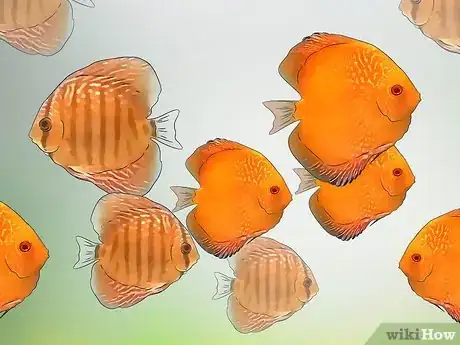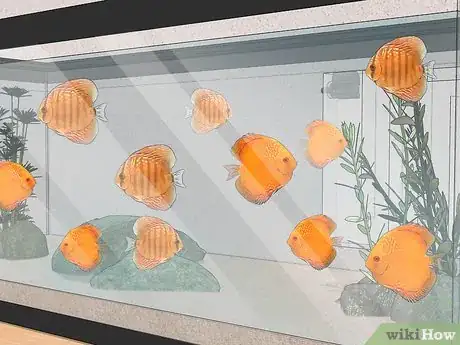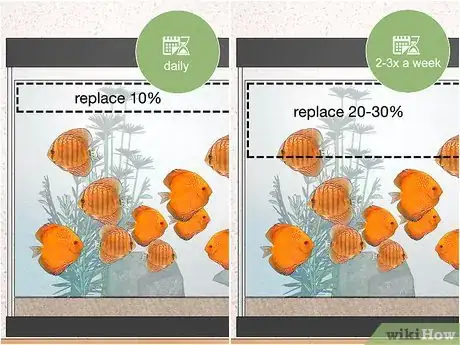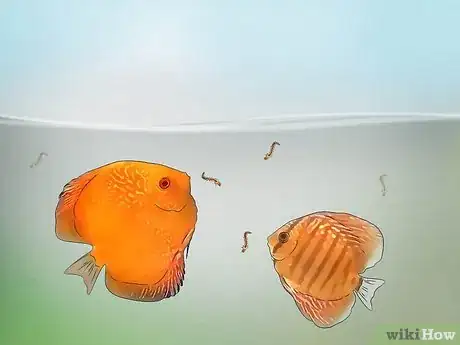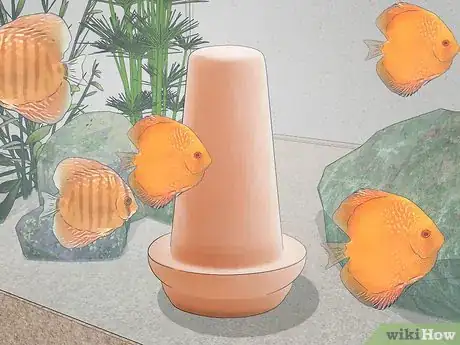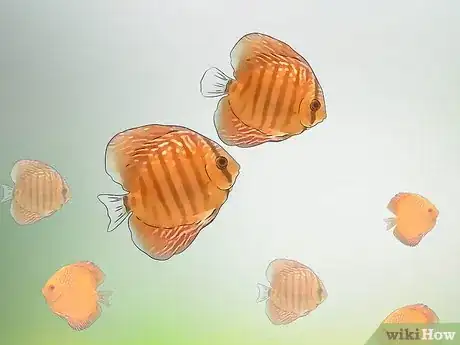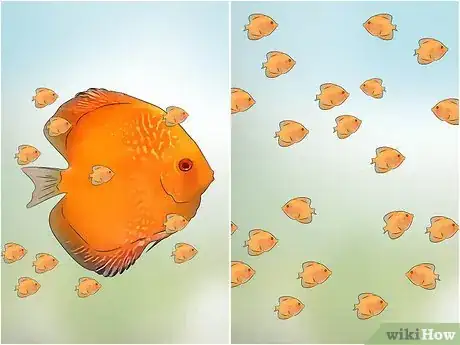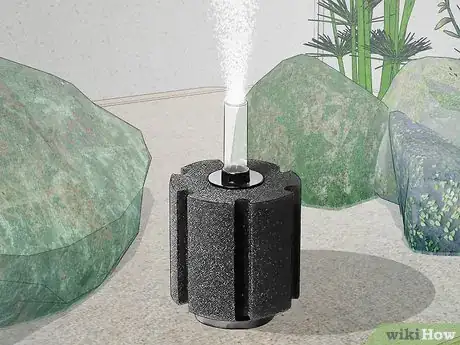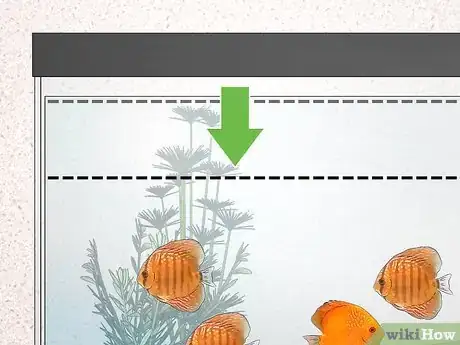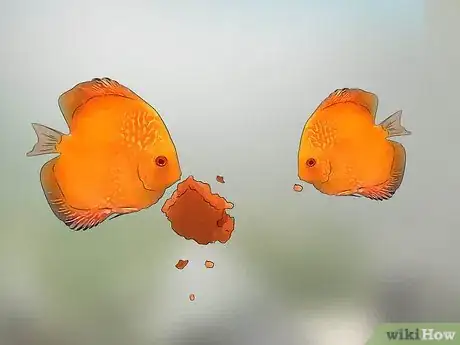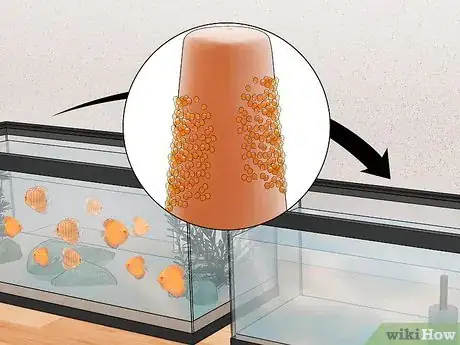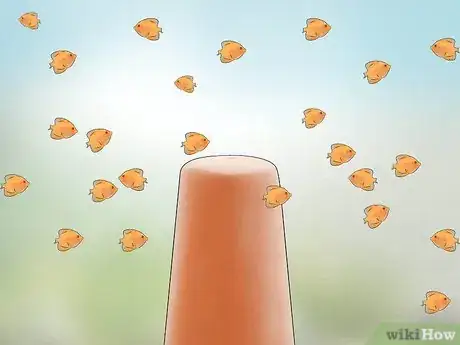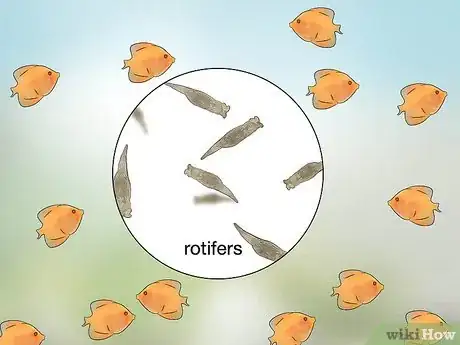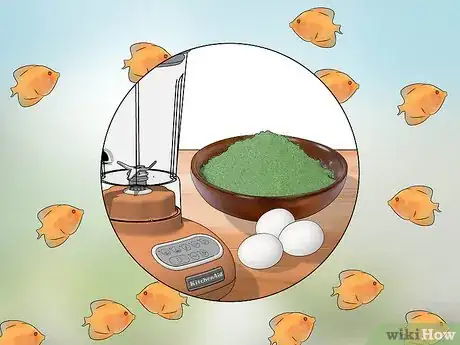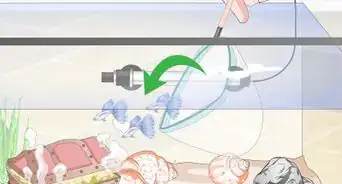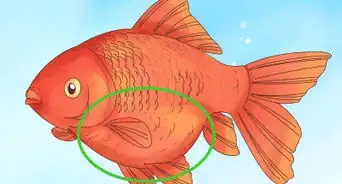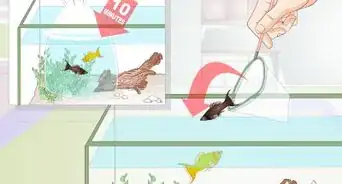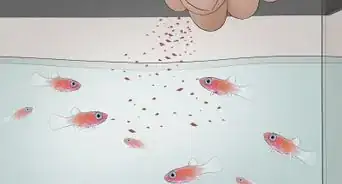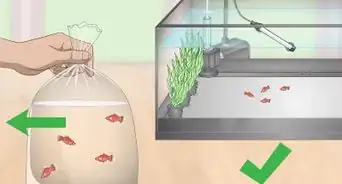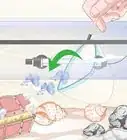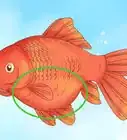This article was co-authored by Marshall Stephens. Marshall Stephens is an Aquarium Expert at Private Oceans Aquariums in West Palm Beach, Florida. Marshall has over 20 years of experience in the aquarium industry and focuses on captive-bred animals. They specialize in tropical and marine aquariums and are a contributor to the Loggerhead Marine life center in Jupiter Florida.
There are 8 references cited in this article, which can be found at the bottom of the page.
wikiHow marks an article as reader-approved once it receives enough positive feedback. In this case, several readers have written to tell us that this article was helpful to them, earning it our reader-approved status.
This article has been viewed 218,659 times.
Discus are quite difficult to care for and breed, and you may not achieve a high survival rate for the young on your first attempt. One feature not found in most other aquarium species is the young fish's instinct to feed from the parents' skin, making them easier to care for if you are willing to leave the two generations in the same tank. However, if you wish to raise the fish in a controlled environment, away from the threat of cannibalism or disease present when adults are around, you will need to feed them a specialized replacement for the parents' nutrients. Both methods begin with creating an environment to encourage breeding, and are then described separately.
Steps
Encouraging Discus to Breed
-
1Keep several fish to increase the odds of having both males and females. There is no surefire way to visually identify discus fish sex, and it is especially difficult before the fish are fully grown. Adult males usually have thicker lips, and may act more aggressive. However, if you have a large enough tank, the best approach is to keep at least four discus fish, to increase the odds of having both a male and a female.
- Some strains of discus may tend to display different patterns on the male and female fish, but this is not guaranteed.[1]
- Females usually mate at about 9 months of age, while males usually mate at 13 months.
-
2Keep your discus fish in a spacious aquarium. Discus are unlikely to breed if they are kept in too small a container. Any discus tank should be at least 15 inches (38 cm) deep.[2] Keep a pair of discus in a tank that can hold at least 50 gallons (191 liters). If you are keeping four to six discus, use a tank that can hold at least 67 gallons (255 liters).[3]Advertisement
-
3Measure and adjust for nitrites, nitrates, and ammonia. Aquarium stores should sell test kits with the tools you need to measure the content of these substances in your water. If your nitrite (with an i) or ammonia levels are above 0 ppm, or your nitrate (with an a) levels are above 20 ppm, the water could be toxic to your fish. Run a fishless cycle if the tank is empty, or consult an experienced aquarium keeper if not.
- Look for a more comprehensive aquarium kit that provides some or all of the testing tools in the steps below.
-
4Thoroughly test other water conditions in your aquarium, and adjust carefully. The temperature in your aquarium should be at 82 degrees F (27.7 C) or higher to create suitable breeding conditions. The water pH test results should be stable around 6.5 pH, never rising to 7.0 or higher. Purchase an electronic conductivity tester to test for mineral content, which should be between 100 and 200 microsiemens.[4] [5] If any of these need adjusting, do so with minimal adjustments to avoid harming the fish, and follow these tips:
- Adding substances to raise or lower the pH will also raise the conductivity reading. Keep measuring all characteristics daily as you make adjustments.
- Adding reverse osmosis water is not recommended unless you need to lower conductivity below 200 microsiemens. In other situations, normal tap water should be fine.
-
5Change a portion of the water frequently. Change 10% of the water daily, or 20–30% of the water twice a week, to keep the tank as clean as possible while you are encouraging the discus to breed. Siphon collected filth from the bottom of the tank whenever necessary. If the sides of the tank need cleaning, do so before the water change, to avoid clouding the new water.
- Sticking to a regular maintenance routine can help your tank stay clean.
-
6Feed your discus animal protein. A variety of live foods such as mosquito larvae, adult brine shrimp, or white worms are best for providing adult discus with the nutrition they need for breeding. If live food is not available, feed them beef heart or, as a last resort, flake food high in animal protein. You may occasionally feed them tropical fish vitamin supplements, powdered spinach, spirulina, or high quality flake food for some extra nutrients.[6] [7]
- Collecting live food from fresh water yourself increases the risk of transmitting disease to your fish. Many aquarium hobbyists purchase from a reliable, disease-free source, then raise the live food at home to lower this risk further.
-
7Add spawning zones to the tank. Surfaces low to the ground may encourage the fish to lay eggs, and will make egg transfer easier if you plan to separate them from the parents. You may use tall, upturned flower pots, a breeding cone from an aquarium store, or a short length of PVC pipe.[8] Keeping the aquarium itself in a quiet place may also increase the odds of breeding occurring.
- Don't worry if the discus lay eggs directly on the floor, as long as the parents are defending the eggs from other fish.
-
8Watch for mated pairs. If a pair of discus fish start hanging out together in a corner, cleaning a spawning area, or acting aggressive to other discus, this is likely a male and a female discus, and they should spawn soon. If the mated pair gets extra aggressive, you may need to separate them from the rest of the tank's inhabitants.
-
9Add methylene blue to the tank. A few drops of methylene blue added to the water helps protect the eggs from bacteria and fungus.[9] Look for this substance at an aquarium store or online, and add with an eyedropper.
-
10Decide whether to raise the discus young with or without the parents. If all goes well, raising the young "fry" with parents may increase the survival rate significantly. However, some discus parents may eat the eggs or fry, or spread diseases. It's possible that discus raised by parents tend to be better parents themselves, which is useful if you plan to continue breeding fish for multiple generations. Continue on to the relevant section once you've made your decision.
- If you or someone you know has an experienced mated pair of discus, you could use those two as surrogate parents[10]
-
11Replace powerful filters with sponge filter or air stone. Tanks with fry should only use gentle methods of water filtration and oxygenation, to prevent sucking in fry or exhausting them with a constant current. Adjust your tank's filters if necessary once you've decided which tank the fry will be raised in.
Raising Discus with Parents
-
1Watch for the eggs hatching. After two or three days, the eggs should hatch. However, the young fish, or fry, typically remain attached to the egg site for some time. If you notice the parents eating the eggs while you are waiting, consider moving the parents and following the instructions for raising discus without parents instead.
-
2Reduce water levels before fry detach (optional). Within a few days of hatching, the fry should detach and move to the parents' sides, where they feed from the parents' skin. You may increase the odds of the fry locating the parents by temporarily reducing the water levels to roughly 9 inches (25cm).[11]
- Discus strains with light coloring may be harder for the fry to locate.
- Remove the surface eggs were attached to, if the fry attempt to feed from it.
-
3Feed with baby brine shrimp four or five days after the fry have been swimming. Once the fry have been swimming freely for about four days, start supplementing their diet with a tiny amount of live baby brine shrimp four times a day.[12]
- Clean out dead shrimp if uneaten on the same day, in order to keep the water clean.
- If you cannot use live, frozen is acceptable. Use a medium slow bubble on the air stone to get the frozen baby brine shrimp moving around the aquarium, or the fry may not recognize it as food.
-
4Change their diet after six weeks. Once the fry have reached six weeks of age, they can eat a greater variety of food. Try to feed them a wide variety of animal protein as well as vitamin-rich vegetables. Many discus breeders are willing to share their own recipe for "discus burger," which contains all these ingredients blended into a consistency that is easy for the small fish to eat.
- You may move the fry to a different tank at this age, away from the parents. This may be necessary to prevent overcrowding.
Raising Discus without Parents
-
1Move the water containing eggs into a new tank. Make sure the new tank has all the same water attributes described in the section on encouraging breeding, but use a smaller tank for a higher chance of success.[13] If the eggs are laid onto the floor of the tank instead of on a pipe or spawning cone, you may need to move the adult fish instead.
- Continue changing the water frequently, as described in the breeding section.
-
2Wait until the young fish are swimming freely. After a couple days, the eggs will hatch, but it may take a couple days before the fry move away from the egg area and start swimming freely.
-
3Ideally, feed them from a clean source of rotifers. Rotifers are microscopic organisms found in pond water. However, rotifers collected in the wild may contain harmful diseases. Instead, purchase a clean source of rotifers from an aquarium store.
- Rotifers may multiply on their own, making exact feeding instructions difficult. Ideally, feed the fry minuscule amounts (the size of a blunt pencil tip) ten or more times a day, or according to the rotifer packaging instructions for fish fry.[14]
-
4Otherwise, make your own mixture of egg yolk and other materials. Many breeders smear egg yolk to the side of the tank for the fry to feed on. This may result in slower growth than the rotifers method, but it may be cheaper or easier. Mix other discus food such as spirulina and baby brine shrimp into the egg yolk for added nutrition. You may need to mix together both hard boiled and raw egg yolk to produce a mixture that sticks to the side of the tank.
- The discus can be fed on ordinary food after six week, although using a recipe for "discus burger" after that point is recommended while they are growing.
Community Q&A
-
QuestionOur fish laid eggs for first time but in morning we found the eggs had been eaten. What steps should we take next time to prevent this?
 Community AnswerIf you can, try to get the discus to lay the eggs on a box crate. that way, you can remove them and care for them without any worry of the parents eating them. As this is the first time, and parent fish are known to eat bad eggs, it may be that you're a tad unlucky, and the eggs weren't fertilized.
Community AnswerIf you can, try to get the discus to lay the eggs on a box crate. that way, you can remove them and care for them without any worry of the parents eating them. As this is the first time, and parent fish are known to eat bad eggs, it may be that you're a tad unlucky, and the eggs weren't fertilized. -
QuestionWhich discus blood strain should I buy to breed and raise the fry to make money?
 Aussie JCommunity AnswerIt depends on what your local market is into. Having uncommon strains would be a good idea, but the price increases with the rarer ones.
Aussie JCommunity AnswerIt depends on what your local market is into. Having uncommon strains would be a good idea, but the price increases with the rarer ones. -
QuestionHow many eggs do discus lay?
 GabeCommunity AnswerThere are many variables that determine how many eggs discus lay but it is normally between a few dozen and a couple hundred. The main variable that determines how many eggs a pair will lay is the breeding experience of the pair.
GabeCommunity AnswerThere are many variables that determine how many eggs discus lay but it is normally between a few dozen and a couple hundred. The main variable that determines how many eggs a pair will lay is the breeding experience of the pair.
Things You'll Need
- Aquarium with a filter
- Baby brine shrimp
- High-protein food, including both animal and vegetable food. For instance, beef heart, blood worms and spinach.
- Aquarium test kit (able to test pH, nitrite, nitrate, ammonia, electrical conductivity, temperature)
References
- ↑ http://forum.simplydiscus.com/showthread.php?96953-Sex-identification-of-Discus
- ↑ http://www.aquaticcommunity.com/breeding/discus.php
- ↑ http://www.aquaticcommunity.com/breeding/discus.php
- ↑ http://www.cichlid-forum.com/articles/breeding_discus.php
- ↑ http://www.cichlid-forum.com/articles/breeding_discus.php
- ↑ http://aquariuminfo.org/discus.html
- ↑ http://www.discushatchery.com/spawningdiscus.html
- ↑ http://aquariuminfo.org/discus.html
- ↑ http://www.discushatchery.com/tipsincreasingdiscusspawnyields.html
- ↑ http://www.discushatchery.com/tipsincreasingdiscusspawnyields.html
- ↑ http://www.chensdiscus.co.uk/breeding
- ↑ http://www.chensdiscus.co.uk/breeding
- ↑ https://www.cichlid-forum.com/threads/rotifers-an-alternative-first-fish-food.456406/#post-3153350
- ↑ https://www.cichlid-forum.com/threads/rotifers-an-alternative-first-fish-food.456406/#post-3153350
About This Article
To breed discus, you'll need a spacious aquarium that holds at least 67 gallons of water, as well as at least 2 discus fish. You may want to put more discus fish in the tank to improve your chances of pairing a male and female. To encourage your discus to breed, feed them animal protein, like mosquito larvae and brine shrimp. Also, add a couple upturned flower pots or PCV pipes to the bottom of the tank so your fish have somewhere to lay eggs. If you notice a pair of fish spending more time together, they might be preparing to breed! To learn how to take care of discus eggs, scroll down!
